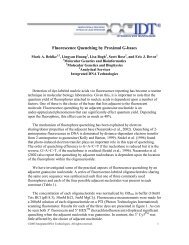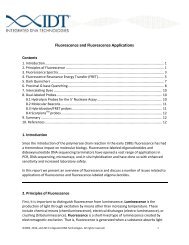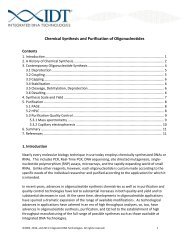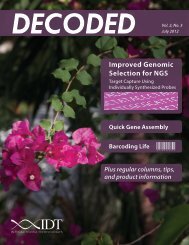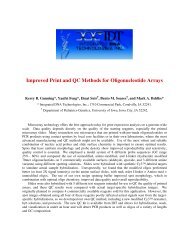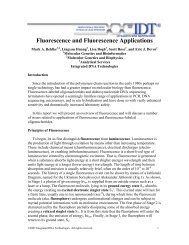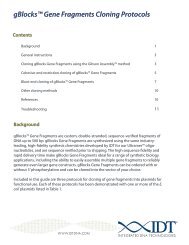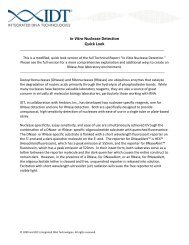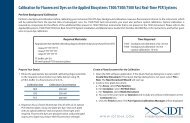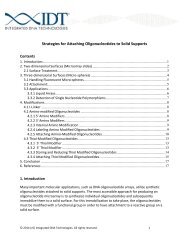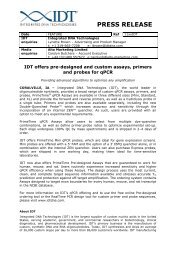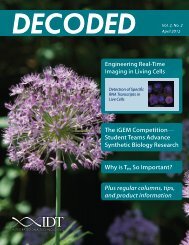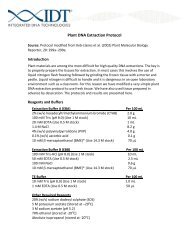Gel Electrophoresis - Integrated DNA Technologies
Gel Electrophoresis - Integrated DNA Technologies
Gel Electrophoresis - Integrated DNA Technologies
You also want an ePaper? Increase the reach of your titles
YUMPU automatically turns print PDFs into web optimized ePapers that Google loves.
<strong>Gel</strong> <strong>Electrophoresis</strong><br />
Contents<br />
A Brief Historical Introduction ............................................................................................ 1<br />
Agarose <strong>Gel</strong> <strong>Electrophoresis</strong> of Nucleic Acids .................................................................... 3<br />
Polyacrylamide <strong>Gel</strong> <strong>Electrophoresis</strong> (PAGE) ....................................................................... 5<br />
Recipes for <strong>Electrophoresis</strong> Tracking Dyes * ........................................................................ 6<br />
A Final Note About Agarose ................................................................................................ 6<br />
References .......................................................................................................................... 7<br />
A Brief Historical Introduction<br />
The term “electrophoresis” was originally meant to refer to the migration of charged<br />
particles in an electrical field. The alternative term “ionophoresis” had been reserved for<br />
the migration of lower molecular weight substances in stabilized media such as gels and<br />
powders [1]. Today, the general term electrophoresis covers all applications regardless<br />
of the material being studied and the medium being used.<br />
Studies by W.B. Hardy around the turn of the twentieth century established that many<br />
biologically important molecules, such as enzymes and other proteins, displayed<br />
characteristic electrophoretic mobilities [2, 3]. The demonstration that biomolecules<br />
migrated in predictable ways in an electrical field attracted a great deal of interest<br />
among biochemists. For example, Michaelis [4] was able to use electrophoresis to<br />
determine the isoelectric points of various enzymes. The isoelectric point, pI, is loosely<br />
defined as the pH at which a protein will no longer migrate in an electrical field. It is<br />
important to note here that electrophoresis made such determinations possible before<br />
researchers were able to actually purify the proteins themselves! In fact, as<br />
electrophoresis methods improved, it was found that some substances that many had<br />
believed were well defined entities via other means such as crystallization were yielding<br />
multiple components in an electrical field. This meant that some “pure” substances<br />
were actually composed of two or more previously unsuspected subunits.<br />
While the majority of the early electrophoretic studies of biomolecules were carried out<br />
in liquid phase, von Klobusitzky and Konig [5] successfully applied an electrophoretic<br />
field to paper strips saturated with an electrolytic solution to separate components of<br />
snake venom. This “paper electrophoresis” pre-dates by several years the technique of<br />
“paper chromatography” with which it is usually associated [6]. During the late 1940s<br />
and early 1950s, this solid phase electrophoresis was used to characterize a vast array of<br />
biologically important substances including the amino acids [7]. The advantage of the<br />
solid support electrophoresis over free solution electrophoresis lies in the ability of the<br />
©2005 and 2011 <strong>Integrated</strong> <strong>DNA</strong> <strong>Technologies</strong>. All rights reserved. 1
solid support to stabilize migration. Such stabilization led to the development of a<br />
precise mathematical theory of molecular migration. It was clear from the outset that<br />
time and the intensity of the electrical field were major determinants of the mobility of<br />
a substance on paper strips. If, however, those two factors were to be held constant,<br />
the mobility of a molecule, u, can be written as,<br />
U = Qd / 4πr 2 η<br />
where Q is the charge on the molecule, d is distance, r is the radius of the molecule, and<br />
η is the viscosity of the solution used to wet the strips. The radius of the molecule could<br />
be experimentally determined from the observed diffusion constant. Note here that the<br />
radius of the molecule is in the denominator of the mobility expression and is squared.<br />
This means that the relationship between molecular size and mobility is non-linear. That<br />
is, all other factors being equal, mobility increases as the inverse square of the size of<br />
the molecule. This will become important later in discussions of electrophoretic<br />
separations of nucleic acids.<br />
The types of apparatus designed for paper electrophoresis are nearly identical to those<br />
in use today for gel electrophoresis. Two of these paper electrophoresis rigs are shown<br />
below in Figure 1.<br />
Figure 1. Diagrams of two paper electrophoresis rigs. The vertical apparatus on the left is from<br />
Williams et al. [8] and the horizontal apparatus on the right is from Grassmann et al. [9].<br />
Compare the horizontal rig design to any modern horizontal gel electrophoresis set up.<br />
While paper and other solid support materials proved to be an advantage over free<br />
solutions for the electrophoretic analysis of biomolecules, gels were adopted later<br />
because gels not only minimized diffusion better than paper supports they actually<br />
participated in the separation process by interacting with the migrating particles. <strong>Gel</strong>s<br />
©2005 and 2011 <strong>Integrated</strong> <strong>DNA</strong> <strong>Technologies</strong>. All rights reserved. 2
can be thought of as semi-solid matrices whose pore sizes aid in separation. The semisolid<br />
nature of the gel participates through a process known as molecular sieving. The<br />
three common media for gel electrophoresis are starch, polyacrylamide, and agarose. Of<br />
these, the starch gel medium is the least versatile whereas a wide range of separation<br />
effects can be achieved using the other two media.<br />
There are limitations to the use of both polyacrylamide and agarose but these are<br />
effectively minimized when the material to be analyzed is a nucleic acid. Even very small<br />
nucleic acids (i.e., oligonucleotides) are easily separated in an electrical field by one or<br />
the other medium. The primary criteria for choosing polyacrylamide or agarose gel<br />
electrophoresis are length and whether or not the nucleic acid is single stranded or<br />
double stranded. Short, single-stranded <strong>DNA</strong>s like oligonucleotides require<br />
polyacrylamide whereas long (>100bp), double stranded <strong>DNA</strong>s are best resolved on<br />
agarose.<br />
Agarose <strong>Gel</strong> <strong>Electrophoresis</strong> of Nucleic Acids<br />
Nucleic acids are polymers composed of individual nucleotide units. The units are<br />
connected via phosphate diester linkages of the backbone sugars. The net effect of<br />
these linkages is to give the polymers a net negative charge. From the earliest days of<br />
electrophoresis it has been axiomatic that molecules carrying an electrical charge will<br />
migrate in an electrical field in a predictable manner. When subjected to an electrical<br />
field, a molecule carrying a net negative charge will migrate toward the positive pole<br />
and a molecule with a net positive charge will migrate toward the negative pole. In a<br />
semi-solid matrix like agarose, the equation describing mobility can be re-interpreted, at<br />
least heuristically, by defining η as gel density or concentration and r as the length of<br />
the molecule. Thus, when they are placed in the semi-solid matrix of a gel, nucleic acids<br />
will migrate toward the positive pole in a predictable and reproducible manner that can<br />
be described as a negative exponential function of length. That is to say, shorter<br />
molecules will migrate faster and longer molecules will migrate slower. Indeed, in the<br />
case of a nucleic acid in a gel in an electrical field, every other element of the migration<br />
expression is a constant and mobility is completely determined by molecular length.<br />
As a matter of practice, it is difficult to accurately resolve double-stranded nucleic acids<br />
smaller than about 100 bases in an agarose gel because the sieving properties of<br />
agarose are not fine enough. On the other end of the scale, molecules longer than about<br />
25,000 bp but shorter than around 2,000,000 bp will all run at the same rate. This is<br />
called limiting mobility. Nucleic acid molecules longer than 2,000,000bp will not even<br />
enter an agarose gel. Thus, the effective size range for agarose gel electrophoresis of<br />
double stranded nucleic acids is between 100bp and 25,000bp. In this range the<br />
behavior of the molecule is precise and predictable. This behavior is shown in figure 2.<br />
As can be seen there is minimal separation of the larger fragments but resolution<br />
improves as the fragments get smaller. While this phenomenon has been known for<br />
many years, what was not known was how the nucleic acid molecules actually moved in<br />
©2005 and 2011 <strong>Integrated</strong> <strong>DNA</strong> <strong>Technologies</strong>. All rights reserved. 3
the gel matrix. In the 1980s a theory was put forward that nucleic acids migrated<br />
through the gel much the same way that a snake moves. That is, the leading edge moves<br />
forward and pulls the rest of the molecule with it. In this model, as the molecule gets<br />
longer resistance to being pulled along increases. This resistance is further increased by<br />
the interaction of the molecule with the gel matrix. As has been discussed above, the<br />
increase in resistance is non-linear. This model, called “biased reptation,” is sufficient to<br />
explain all of the behavior of a nucleic acid in a semi-solid matrix [10, 11]. In 1989 a<br />
group at the University of Washington put this theory to the test. They filmed <strong>DNA</strong><br />
molecules moving through an agarose gel. Their films showed both reptation and the<br />
nucleic acid/gel matrix interactions [12].<br />
23,130<br />
9,416<br />
6,557<br />
4,361<br />
2,322<br />
2,027<br />
564<br />
Distance<br />
Figure 2. Electrophoretic mobility of <strong>DNA</strong> restriction fragments in an agarose gel. The <strong>DNA</strong> is<br />
from bacteriophage lambda digested with the restriction enzyme Hind III. The graph shows<br />
migration distance in centimeters by size of the restriction fragment in base pairs.<br />
In the mid-1980s a number of methods were developed to electrophoretically analyze<br />
nucleic acid molecules in the limiting mobility size range. The solution involved<br />
artificially introducing a size dependent mobility on nucleic acid molecules by altering<br />
the electrophoretic field. The first such alteration involved simply switching the polarity<br />
of the field in a regular pattern. Carle et al. [13] showed that periodic reversals of<br />
polarity would induce the molecules to make U-turns in the gel. Even at very large sizes,<br />
this turning would permit separation of molecules. If the length of time the molecules<br />
were reversed was about one-third the time they were oriented forward, for example<br />
three seconds forward and one second back, molecules as large as 2,000,000bp could<br />
be resolved in a standard agarose gel in a few hours. The first practical demonstration of<br />
©2005 and 2011 <strong>Integrated</strong> <strong>DNA</strong> <strong>Technologies</strong>. All rights reserved. 4
this method, called Field Inversion <strong>Gel</strong> <strong>Electrophoresis</strong> (FIGE), was to completely resolve<br />
intact yeast chromosomes [14]. Since then, a variety of methods collectively termed<br />
pulsed-field gel electrophoresis, have been developed [15].<br />
Polyacrylamide <strong>Gel</strong> <strong>Electrophoresis</strong> (PAGE)<br />
Polyacrylamide gel is the result of polymerizing acrylamide monomers into long chains<br />
and then cross-linking the chains with a bifunctional compound. A number of these<br />
bifunctional cross-linkering compounds are known including ethylene diacrylate, N,N’-<br />
bisacrylycystamine (BAC), and N,N’-diallyltartardiamide (DATD). However, the most<br />
generally useful compound is N,N’-methylene bisacrylamide (bis meaning two).<br />
Polymerization of acrylamide and bisacrylamide is catalyzed in the presence of either<br />
ammonium persulphate or riboflavin. In addition, the compound N,N,N,N’-<br />
tetramethylethyldiamine (TEMED) or, less commonly, 3-dimethylamino proprionitrile<br />
(DMAPN), are introduced to accelerate the polymerization process. In the ammonium<br />
persulphate-TEMED system that is conventionally employed, TEMED catalyzes the<br />
formation of free radicals from persulphate and these free radicals initiate<br />
polymerization. Since the free base of TEMED is required, polymerization can be slowed<br />
at lower pH and can be prevented entirely at very low pH. Polymerization rates can be<br />
increased by increasing the TEMED or persulphate concentrations. Also, temperature<br />
has a direct relationship with speed of polymerization. For this reason, the persulphate<br />
and the acrylamides are usually stored at –20 o C.<br />
In contrast to persulphate polymerization, the use of riboflavin-TEMED requires light to<br />
initiate polymer formation. Light causes photo-decomposition of riboflavin which<br />
generates the necessary free radicals.<br />
As with agarose, the sieving properties of polyacrylamide gels depends upon the<br />
effective pore size of the gel. Effective pore size decreases as the concentration of the<br />
acrylamide increases. As pore size decreases the ability of the gel to resolve smaller and<br />
smaller molecules increases. Polyacrylamide gels have effective pore sizes that are much<br />
smaller than agarose gels at any concentration and, thus, they are ideal for resolving<br />
nucleic acids in the size range of oligonucleotides. The relationship between gel<br />
concentration and resolving power can be simply demonstrated by observing the<br />
behavior of tracking dyes in gels. The two common dyes are bromophenol blue and<br />
xylene cyanole. These chemicals have a net negative charge and they will migrate in<br />
gels the same way that nucleic acids do. The usefulness of these dyes is that they will<br />
migrate as if they were nucleic acids of different lengths depending upon gel type and<br />
concentration. This phenomenon is shown in Table 1.<br />
©2005 and 2011 <strong>Integrated</strong> <strong>DNA</strong> <strong>Technologies</strong>. All rights reserved. 5
Table 1<br />
Migration of tracking dyes in gel electrophoresis.<br />
The numbers given below each dye reflect the approximate length of a <strong>DNA</strong> molecule with<br />
which the dye will migrate in a gel of the stated type and concentration.<br />
<strong>Gel</strong> Type and Concentration Bromophenol Blue Xylene cyanole<br />
Agarose 0.8% 500 3500<br />
Acrylamide 3.5% 100 460<br />
5.0% 65 260<br />
8.0% 45 160<br />
12.0% 20 70<br />
15.0% 15 60<br />
20.0% 12 45<br />
Recipes for <strong>Electrophoresis</strong> Tracking Dyes *<br />
Dye I (6X concentrate): 0.25% (w/v) bromophenol blue, 0.25% (w/v) xylene cyanol,<br />
40% (v/v) sucrose in sterile water. Store at 4 o C.<br />
Dye II (6X concentrate): 0.25% (w/v) bromophenol blue, 0.25% (w/v) xylene cyanol,<br />
15% (v/v) Ficoll Type 400 in sterile water. Store at RT.<br />
Dye III (6X concentrate): 0.25% (w/v) bromophenol blue, 0.25% (w/v) xylene cyanol,<br />
30% (v/v) glycerol in sterile water. Store at 4 o C.<br />
*recipes adapted from Maniatis et al. [16].<br />
A Final Note About Agarose<br />
During the 1980s and 1990s a considerable effort was made on the part of several<br />
companies to develop “designer” agarose. These are different formulations that have<br />
very specific sieving properties. Among these are products like SeaKem, SeaPlaque,<br />
NuSeive, MetaPhor, and so on. We have tried many of these with varying degrees of<br />
success. One type that does work very well for us is the so-called Low Melting Point<br />
(LMP) agaroses. Compared to a 1.4% standard agarose, 1.2% LMP gels give superior<br />
resolution in the all-important 100bp to 500bp size range.<br />
Anyone interested in these various types of agarose should visit the BioWhittaker/<br />
Cambrex web site (www.cambrex.com) and search on “agarose.”<br />
©2005 and 2011 <strong>Integrated</strong> <strong>DNA</strong> <strong>Technologies</strong>. All rights reserved. 6
References<br />
1. Tiselius A. (1959) Introduction. In: M. Bier (ed.) <strong>Electrophoresis</strong>: Theory, Methods, and<br />
Applications. New York: Academic Press. xv−xx.<br />
2. Hardy WB. (1899) On the coagulation of proteid by electricity. J Physiol, 24: 288−304.<br />
3. Hardy WB. (1905) Colloidal solution. The globulins. J Physiol, 33: 251−337.<br />
4. Michaelis L. (1909) Elektrische überführung von fermenten. Biochemische Zeitschrift,<br />
16: 81−86.<br />
5. von Klobusitzky D and König P. (1939) Biochemische studien über die gifte der<br />
schlangengattung Bothrops. VI. Arch Exp Pathol Pharmakol, 192: 271−275.<br />
6. Consden R, Gordon AH, and Matrin AJP. (1944) Qualitative analysis of proteins: a<br />
partition chromatography method using paper. Biochem J, 38: 224−232.<br />
7. Wunderly C. (1959) <strong>Gel</strong> structure and the diffusion of proteins. Clin Chim Acta, 4:<br />
754−759.<br />
8. Williams FG, Pickles EG, and Durrum EL. (1955) Improved hanging-strip paper<br />
electrophoresis technique. Science, 121: 829−832.<br />
9. Grassmann W, Hannig K, and Knedel M. (1955) Über ein verfahren zur<br />
elektrophoretischen bestimmung der serum proteine auf filtrierpapeir. Deutsche<br />
Medizinische Wochenschrift, 76: 333−339.<br />
10. Lerman LS and Frisch HL. (1982) Why does the electrophoretic mobility of <strong>DNA</strong> in<br />
gels vary with the length of the molecule? Biopolymers, 21: 995−997.<br />
11. Lumpkin OJ, Dejardin P, and Zimm BH. (1985) Theory of gel electrophoresis of <strong>DNA</strong>.<br />
Biopolymers, 24: 1573−1593.<br />
12. Smith SB, Aldridge PK, and Callis JB. (1989) Observation of individual <strong>DNA</strong> molecules<br />
undergoing gel electrophoresis. Science, 243: 203−206.<br />
13. Carle GF, Frank M, and Olson MV. (1986) Electorphoretic separations of large <strong>DNA</strong><br />
molecules by periodic inversion of the electric field. Science, 232: 65−68.<br />
14. Carle GF and Olson MV. (1984) Separation of chromosomal <strong>DNA</strong> molecules from<br />
yeast by orthogonal-field-alternation gel electrophoresis. Nucleic Acids Res, 25:<br />
564−567.<br />
15. Lai E, Birren BW, et al. (1989) Pulsed field gel electrophoresis. Biotechniques, 7:<br />
34−42.<br />
16. Maniatis T, Fritsch EF, and Sambrook J. (1982) Molecular Cloning: A Laboratory<br />
Manual. Cold Spring Harbor: Cold Spring Harbor Laboratory Press.<br />
©2005 and 2011 <strong>Integrated</strong> <strong>DNA</strong> <strong>Technologies</strong>. All rights reserved. 7



